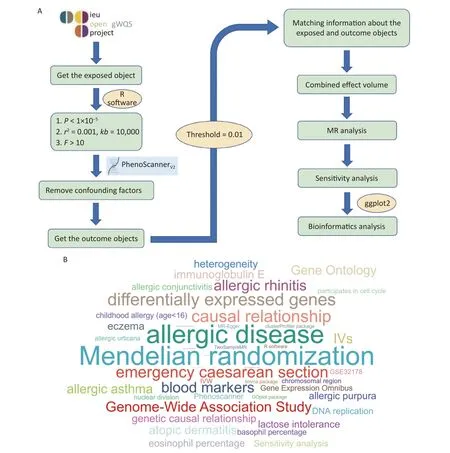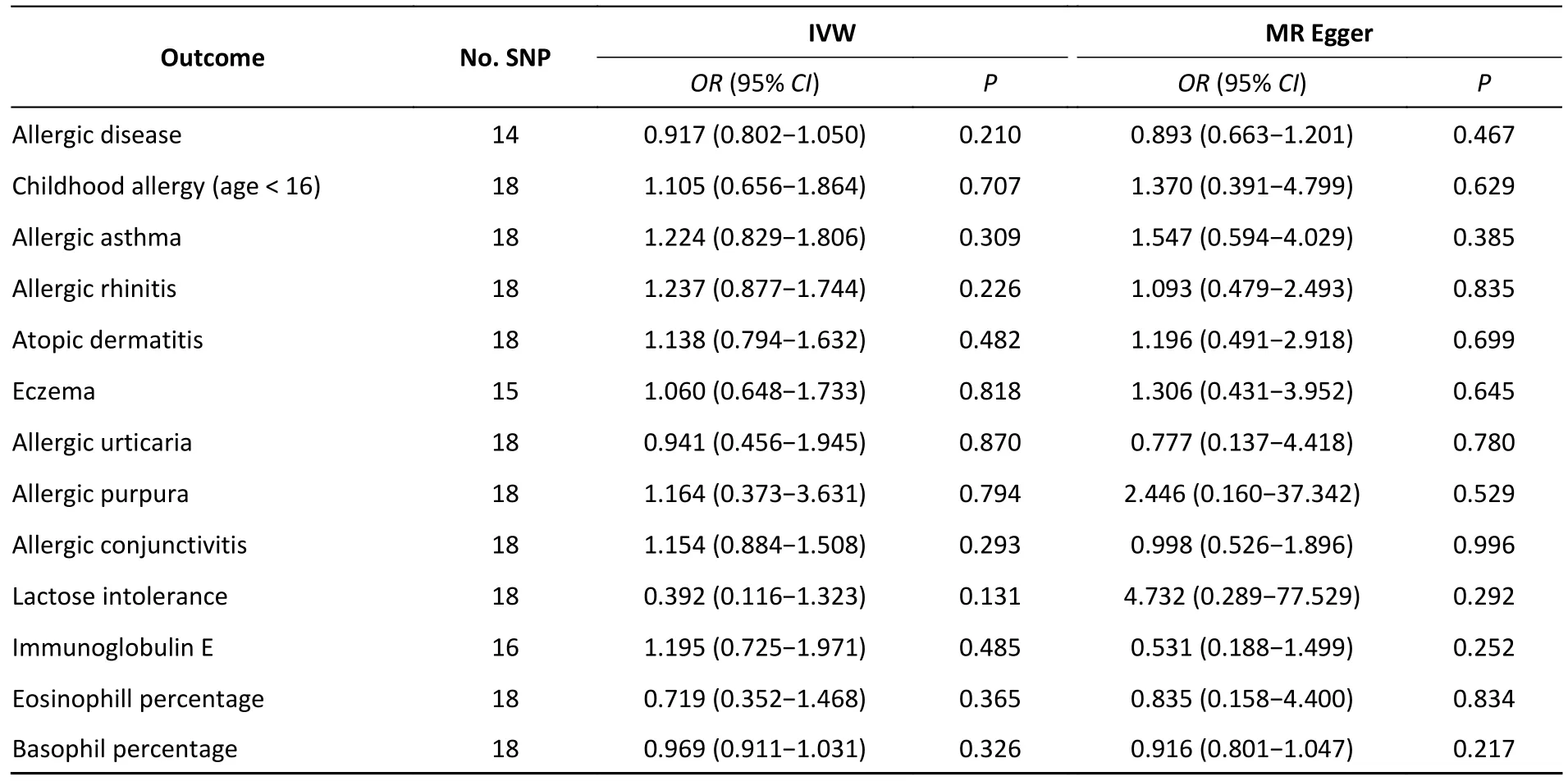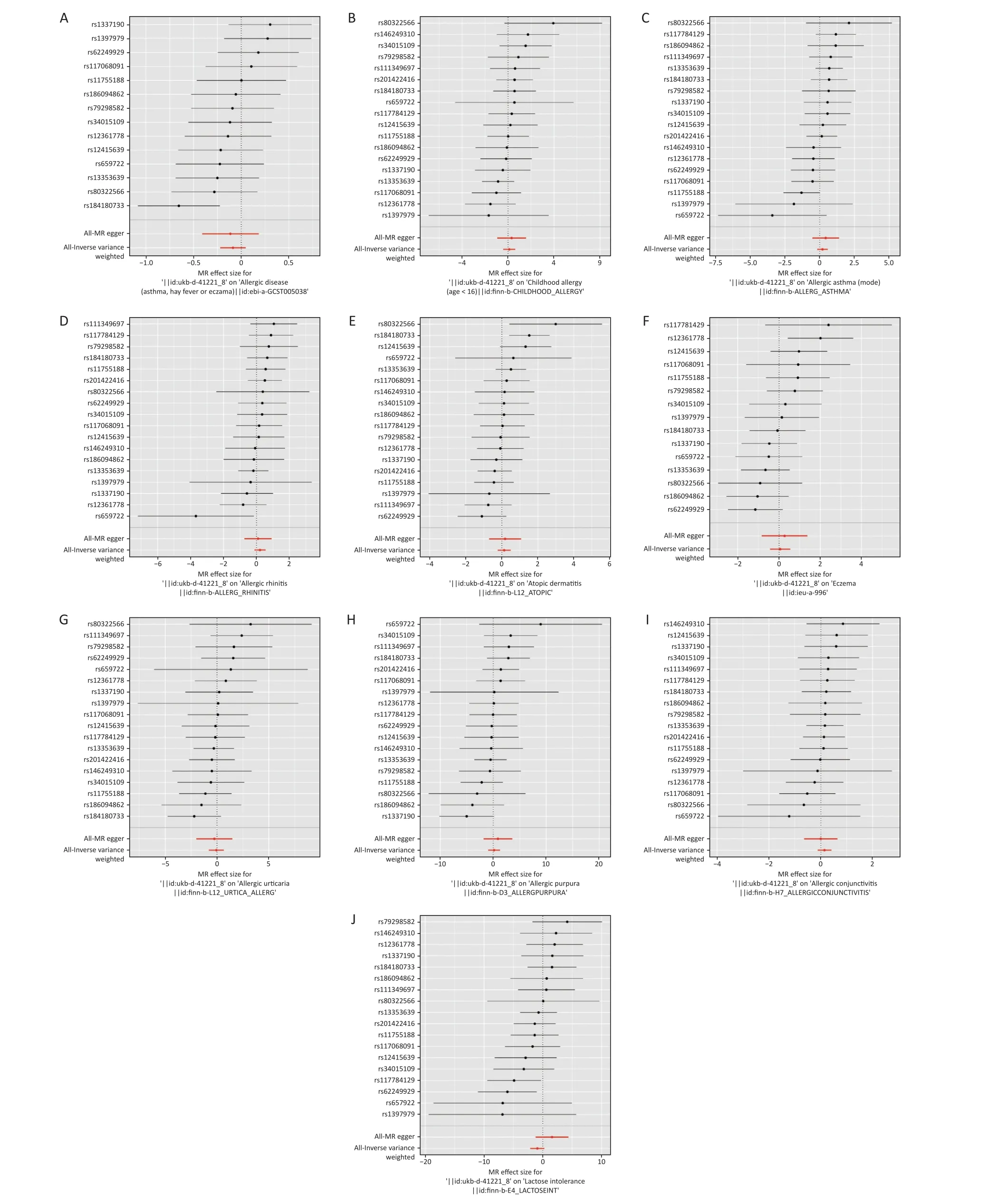Mendelian Randomization Analysis to Analyze the Effect of Emergency Caesarean Section on Different Allergic Diseases and Related Blood Markers*
LI Yu Jian and KAN Xuan
Caesarean section is a well-established surgical procedure that allows for maximum fetal rescue under special circumstances, such as intrauterine distress and intrauterine hypoxia, and minimizes injuries to pregnant women who cannot tolerate vaginal delivery.Emergency caesarean section is a special type of caesarean section that plays an important role in protecting the lives of pregnant mothers and fetuses[1].Allergic diseases, including allergic asthma, allergic rhinitis, and atopic dermatitis, affect at least 20% of the global population and their incidence continues to increase annually, affecting both the physical and mental health of patients and imposing a huge economic burden on society and families[2].Immunoglobulin E(IgE)-mediated type I hypersensitivity reactions are the most common type of allergic disease, and the eosinophil percentage in blood tests is one of the most common clinical indicators.
In recent years, the debate and research on the relationship between caesarean section and allergic diseases have increased each year.A meta-analysis of one randomized control trial (RCT) and 79 cohort studies showed that children delivered by caesarean section had a higher risk of asthma[3].However, one study followed 4,779 children for 4 years and found insufficient evidence of a correlation between caesarean section and eczema, asthma, and food allergies[4].Considering the maturity of caesarean section techniques and the increasing incidence of allergic diseases worldwide every year, it is important to clarify whether a causal relationship exists between caesarean sections and different allergic diseases.Moreover, there is an urgent need to find new epidemiological techniques because traditional epidemiological methods, such as cohort studies, are subject to confounding factors and ethics and thus fail to obtain exact causal relationships[5].
Advances in genomics and genetic epidemiology have led to the identification of numerous genetic variants associated with various human diseases.Mendelian randomization (MR) is an epidemiological technique that is used to assess causality using genetic data.As the human genome cannot be changed at will once it is identified, MR greatly reduces the influence of confounding factors and thus obtains more reliable causal associations[5].Following the principles of random assignment and free association and combining the three core assumptions of instrumental variables (IVs), namely,the assumption of association, independence, and exclusivity, we used MR analysis to analyze the effects of emergency caesarean section on different allergic diseases and associated blood markers.
Data for this study were obtained from the OpenGWAS database (https://gwas.mrcieu.ac.org//).Data from exposure subjects (emergency caesarean section) and outcome subjects (allergic disease,childhood allergy (age < 16 years), allergic asthma,allergic rhinitis, atopic dermatitis, eczema, allergic urticaria, allergic purpura, allergic conjunctivitis,lactose intolerance, IgE, eosinophil percentage, and basophil percentage were extracted for subsequent analysis using the TwoSampleMR package in R software (version 4.3.0, Publisher: R Foundation for Statistical Computing, Place of publication: Vienna,Austria).IVs were screened for the following conditions: 1) correlation with emergency caesarean section (P< 1 x 10-5); 2) exclusion of linkage disequilibrium (LD) (r2> 0.001,kb= 10,000);3) validation of the strength of association between IVs and exposed subjects (F> 10); and 4) removal of confounding factors using the Phenoscanner database (http://www.phenoscanner.medschl.cam.ac.uk/)[6].The above conditions screened for more reliable IVs in this study, thus increasing the reliability of the results.A flowchart and word cloud chart outlining the process of data collection are shown in Figure 1.This Genome-Wide Association Study (GWAS) contained 9,538 and 969 SNPs, and 18 IVs were included after rigorous screening.The GWAS ID for emergency caesarean sections was ukbd-41221_8 and contained 8,019 samples, including 1,158 from the experimental group and 6,861 from the control group.The relevant studies of the outcome subjects were mainly published between 2016–2021, and the study populations were mainly from European and Greater Middle Eastern regions(Supplementary Tables S1–S2, available in www.besjournal.com).

Figure 1.Outline of data acquisition.(A) flow chart.(B) word cloud chart.
MR analysis includes five analysis methods,among which inverse variance weighted (IVW) and MR-Egger are the most important for this study.AP< 0.05, indicated that emergency caesarean section affected patient outcomes.Heterogeneity between each IV was verified using a heterogeneity test.WhenP> 0.05, no heterogeneity was considered to exist, and a fixed-effects model was selected for MR analysis.WhenP< 0.05,heterogeneity was considered to exist, and a random-effects model was selected.The sensitivity of MR analysis results to individual IV was verified using leave-one-out sensitivity analysis.The presence of horizontal pleiotropy among multiple IVs was verified using a multiple validity test that ensured both correlation and independence between the IVs and exposed objects.The results of IVW analysis were used as the main results of MR analysis whenP> 0.05 was considered as no horizontal pleiotropy, and the results of MR-Egger analysis were used as the main results of MR analysis whenP< 0.05 was considered as horizontal pleiotropy.MR analysis showed no causal relationship between emergency caesarean section and allergic disease or childhood allergies (age < 16 years) (P> 0.05).Additionally, there was no causal relationship between emergency caesarean section and eight specific allergic diseases (allergic asthma,allergic rhinitis, atopic dermatitis, eczema, allergic urticaria, allergic purpura, allergic conjunctivitis, and lactose intolerance) (P> 0.05) (Table 1, Figure 2, and Supplementary Figure S1, available in www.besjournal.com).Finally, MR analysis of emergency caesarean sections and blood markers of allergic diseases showed no causal relationship between emergency caesarean sections and IgE, eosinophil percentage, or basophil percentage (P> 0.05)(Table 1 and Supplementary Figure S2, available in www.besjournal.com).The results of the heterogeneity test were considered significant atP> 0.05.Therefore, it can be concluded that there was no heterogeneity among the IVs, and the fixedeffects model was selected to present the results of the MR analysis (Supplementary Figure S3, available in www.besjournal.com).The multiplicity test also showedP> 0.05.Therefore, we concluded that there was no horizontal multiplicity among the IVs, and the results of the IVW analysis were selected as the main results of the MR analysis (Supplementary Table S3 and Supplementary Figures S4–S5, available in www.besjournal.com).
GSE18850 is a dataset related to caesarean sections obtained from the Gene Expression Omnibus (GEO) database (https://www.ncbi.nlm.nih.gov/gds/).Differential expression analysis was performed using the limma package to obtain caesarean section-related differentially expressed genes (DEGs), and the results were visualized using the ggplot2 package.The results of the MR analysis were validated by comparing whether the identified DEGs intersected with caesarean section-associated blood marker genes.The obtained DEGs were analyzed for Gene Ontology (GO) and Kyoto Encyclopedia of Genes and Genomes (KEGG)enrichment using clusterProfiler and GOplot packages to understand the main functions and pathways associated with the DEGs.A total of 21 DEGs (|log2(FC)| > 2 andPadj < 0.05) were obtained, of which five were highly expressed and 16 were lowly expressed.Genes capable of expressing allergic disease-related blood markers were not detected among the 21 DEGs (Supplementary Figure S6A–B and Supplementary Table S4, available in www.besjournal.com).Enrichment analysis revealed that the main functions of the DEGs included nuclearspeckling and muscle tissue development, and the corresponding pathways were not predicted(Supplementary Figure S6C–D).

Table 1.Main results of MR analysis

Figure 2.Forest diagram of MR analysis.(A) allergic disease.(B) childhood allergy (age < 16).(C) allergic asthma.(D) allergic rhinitis.(E) atopic dermatitis.(F) eczema.(G) allergic urticaria.(H) allergic purpura.(I) allergic conjunctivitis.(J) lactose intolerance.MR: Mendelian randomization.
The results of the MR analysis in this study are contradictory to previous traditional epidemiological and observational studies.A study by Gürdeniz showed that caesarean section could increase the risk of asthma by interfering with the immune response and the development of gut microbes[7].In this study, the most recent and largest sample size of GWAS datasets were used.The absence of heterogeneity and horizontal pleiotropy in the analysis and the smallestF-value of 20 suggest that there were no weak IVs in this study.Therefore, the finding that there was no causal relationship between the exposure and outcome was more accurate.Traditional epidemiological statistical methods may not be able to exclude unknown confounding factors well, while MR analysis can better exclude the interference of confounding factors on causality from a genetic perspective that cannot be easily changed[5].In a large cohort study,there was no correlation between caesarean section and allergic rhinitis in children at 6, 8, and 10 years after birth, after correcting for confounders[8].However, most patients undergoing emergency caesarean section often have multisystem diseases associated with allergic diseases, such as premature birth, immune abnormalities, and genetic metabolic diseases.Patients with allergic diseases often have abnormalities in immune and inflammatory factors or a history of living in a particular environment,such as haze[9].These known or unknown immune,inflammatory, and environmental pathways as well as the comorbidities associated with these pathways may lead to false-positive statistical results in traditional epidemiology.
Bioinformatics, a research method that has received considerable attention in recent years, was used to reverse-validate the results of this study.Genes significantly associated with blood markers of allergic diseases were not among the 21 DEGs identified by differential expression analysis.HINT3 was the most significantly differentially expressed gene and was primarily associated with breast cancer[10].In addition, no major functions or DEG pathways were significantly associated with blood markers of allergic diseases, which validated the results of the MR analysis in this study and suggested the influence of confounding factors on the results of previous epidemiological studies.
The present study has some limitations.First, the samples included in this study were mainly from European and Greater Middle Eastern countries, and a geographical selection bias may have occurred.Therefore, the findings of this study may not apply to other Asian ethnic groups.In addition, to enable rigorous sensitivity analysis,P< 1 x 10-5was chosen as the association threshold for screening IVs in this study.Although ther2andFvalues were strictly limited and the results were secondarily validated using bioinformatics, the possibility of false-positive or false-negative results could not be completely excluded.Finally, although we used MR analysis and bioinformatics to validate the results of this study,experimental molecular validation of the mechanism and pathway is still lacking, and more in-depth studies should be considered on this basis subsequently.
In conclusion, the two-sample MR analysis in this study showed no causal relationship between emergency caesarean section and allergic diseases such as allergic asthma, allergic rhinitis, and atopic dermatitis or blood markers such as IgE and eosinophil percentage.Our study provides a new direction for subsequent research on the mechanisms and risk factors of allergic diseases and alleviates public misconceptions and fears about caesarean sections.
The authors would like to thank the OpenGWAS database (https://gwas.mrcieu.ac.uk/) and GEO databases (https://www.ncbi.nlm.nih.gov/gds/).
#Correspondence should be addressed to KAN Xuan,Professor, Chief Physician, Master's Advisor, Tel: 86-13920390216, E-mail: ashelykx@126.com
Biographical note of the first author: LI Yu Jian, male,born in 1997, Master's Degree Student, majoring in respiratory.Tel: 86-13820823219, E-mail: yujianli@tmu.edu.cn.
Received: May 18, 2023;
Accepted: July 10, 2023
 Biomedical and Environmental Sciences2023年11期
Biomedical and Environmental Sciences2023年11期
- Biomedical and Environmental Sciences的其它文章
- Decontamination Efficacy of Disinfection and Doffing of Medical Protective Clothing: A Combined Mannequin and Personnel Study*
- SARS-CoV-2 lnfection Risk Factors in Beijing during November 2022: A Case Control Study*
- Association between Temperature Changes and Cardiovascular Mortality Risk in A High-latitude City in Northeast China*
- The Value of Prealbumin and its Combination with NT-proBNP for Predicting in-hospital Mortality in Patients with Heart Failure: Real-World Research Based on Propensity Score Matching
- Effects of Differential First-Line Antiretroviral Therapy (ART)Regimens on Mortality among HlV/AlDS Children in Southwest China: A 15-year Retrospective Cohort Study*
- The Psychosomatic Traits of “People with the Five Elements in Traditional Chinese Medicine”: A Qualitative Study*
